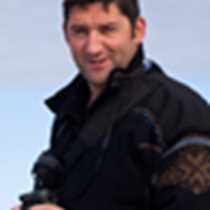Cocos Island, Eastern Tropical Pacific
Cocos Island is a single outcrop of rock sitting 300 miles to the southwest of Costa Rica, to which the island belongs. Our only means of access was by boat. The island’s beauty was immediately apparent as we arrived first thing in the morning.
Local Rangers came onboard and gave a presentation about important marine protection issues and the effects of longline fisheries. The National Geographic Explorer sat in the shelter of Wafer Bay, which allowed easy access by Zodiac to the shore where our intrepid guests searched for three endemic bird species; the finch, the flycatcher and the cuckoo.
The island is famous for incredible underwater encounters with various species of the much-misunderstood shark. Joining a local guide, I dived at some of the shark hotspots eager to gain high-definition footage of these fascinating animals. Almost immediately after sinking below the waves we began to see sharks. First to appear were white-tipped reef sharks, easily identifiable by their flattened head and striking white fin markings. These sharks hunt predominantly at night when large gangs of white-tipped reef sharks invade the reef to seek out fish resting amongst the coral. Divers and snorkelers often see white-tipped reef sharks resting on the seabed and laconically flowing water over their gills by pumping their jaws. Galápagos sharks were also seen and the largest silvertip shark I have ever dived with, plus marbled stingrays and a spotted eagle ray.
Strong currents and seamounts attract one particular shark in the hundreds; the scalloped hammerhead. These fourteen-foot sharks certainly have one of the most curious designs in the animal kingdom. There has been much speculation as to the purpose of their T-shaped head; perhaps it serves as a hydroplane or maybe a sensory array. I managed to gain some up-close-and-personal footage of the hammerheads as they were cleaned by reef fish. The sharks slow down to the point of almost sinking and this invites butterfly fish to pick at parasites and dead skin which irritates the shark. I was delighted to have the opportunity to share this experience and hopefully dispel some ugly rumors about these ancient animals.
In the afternoon we enjoyed hours of snorkeling over the reef and Zodiac cruises along the dramatic shoreline. At one point torrential rain threatened to dampen our spirits but warm tropical showers are quite different! All-in-all a very busy day was had by all and so we looked forward to some relaxation as the ship turned toward Ecuador.
Cocos Island is a single outcrop of rock sitting 300 miles to the southwest of Costa Rica, to which the island belongs. Our only means of access was by boat. The island’s beauty was immediately apparent as we arrived first thing in the morning.
Local Rangers came onboard and gave a presentation about important marine protection issues and the effects of longline fisheries. The National Geographic Explorer sat in the shelter of Wafer Bay, which allowed easy access by Zodiac to the shore where our intrepid guests searched for three endemic bird species; the finch, the flycatcher and the cuckoo.
The island is famous for incredible underwater encounters with various species of the much-misunderstood shark. Joining a local guide, I dived at some of the shark hotspots eager to gain high-definition footage of these fascinating animals. Almost immediately after sinking below the waves we began to see sharks. First to appear were white-tipped reef sharks, easily identifiable by their flattened head and striking white fin markings. These sharks hunt predominantly at night when large gangs of white-tipped reef sharks invade the reef to seek out fish resting amongst the coral. Divers and snorkelers often see white-tipped reef sharks resting on the seabed and laconically flowing water over their gills by pumping their jaws. Galápagos sharks were also seen and the largest silvertip shark I have ever dived with, plus marbled stingrays and a spotted eagle ray.
Strong currents and seamounts attract one particular shark in the hundreds; the scalloped hammerhead. These fourteen-foot sharks certainly have one of the most curious designs in the animal kingdom. There has been much speculation as to the purpose of their T-shaped head; perhaps it serves as a hydroplane or maybe a sensory array. I managed to gain some up-close-and-personal footage of the hammerheads as they were cleaned by reef fish. The sharks slow down to the point of almost sinking and this invites butterfly fish to pick at parasites and dead skin which irritates the shark. I was delighted to have the opportunity to share this experience and hopefully dispel some ugly rumors about these ancient animals.
In the afternoon we enjoyed hours of snorkeling over the reef and Zodiac cruises along the dramatic shoreline. At one point torrential rain threatened to dampen our spirits but warm tropical showers are quite different! All-in-all a very busy day was had by all and so we looked forward to some relaxation as the ship turned toward Ecuador.



